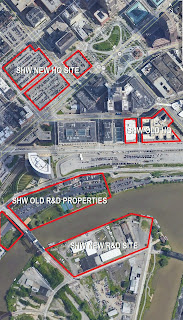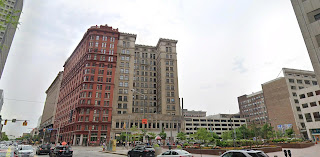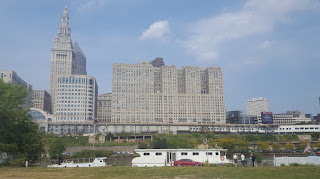 |
| Scranton Peninsula is a blank canvas waiting for developers to make their mark. That is starting to happen on the 22 acres of the Thunderbird site in the foreground. But another 60 acres belong to Scranton Averell and lack any development plans. Nine of those acres were sought by Sherwin-Williams for its new research center but that deal is now dead (Aerial Agents). CLICK IMAGES TO ENLARGE |
City and state officials, including Mayor Frank Jackson, met with SHW executives at least twice in the past week upon learning that the planned new R&D facility was at risk of leaving Cleveland, two of the sources said. But there is no word that any new sites in Cleveland were of interest to SHW.
The clock is ticking, however. SHW executives reportedly want to announce their new headquarters (HQ) and R&D facilities in the coming week.
It is worth noting that this uncertainty doesn't extend to SHW's HQ. The massive, 1.45-million-square-foot HQ will be on the parking lots owned by Jacobs and Weston groups west of Public Square in downtown Cleveland, multiple sources say. The HQ will consolidate up to 5,000 employees from multiple offices throughout Northeast Ohio and even from other states.
The site SHW wanted for its new 350,000-square-foot R&D facility is on about 9.4 acres at 1840-1888 Carter Rd. on Scranton Peninsula in the Flats. It's a floodplain across the Cuyahoga River from Tower City Center that has been home to foundries and mills since before the Civil War.
And the site reportedly has lots of environmental problems wrought by 170 years of industrial activity. Toxins from that activity remain in the soil and must be cleaned and/or covered by new, clean fill dirt before new uses can be built there.
Landing a company with deep pockets and a thousand well-paid R&D employees seemed like a wonderful motivation to finally get that land cleaned and redeveloped after languishing for decades.
A well-known Cleveland developer who agreed to speak off the record confirmed that the SHW deal with Scranton Averell was dead and put the onus on Scranton Averell President Thomas Stickney.
Another real estate source said that, while he would have liked to have seen SHW's R&D facility on Scranton Peninsula, he said that there are other developers who are pursuing many smaller-scale projects on numerous Flats properties nearby.
But when asked if that included Scranton Averell's other properties, he wrote "No...not at all LOL ...everything except their land." He described Scranton Averell's board meetings as being "like family reunions" and not held often.
An e-mail seeking comment from Stickney, sent to his Rocky River law firm's main email, was not responded to prior to publication of this article. The e-mail also included a read-receipt, to which there also was no response.
In fairness, Scranton Averell probably wasn't going to profit by spending millions of dollars to clean its land prior to a sale that might yield a similar amount. SHW probably wasn't going to spend that money either, not when cleaner alternative sites exist elsewhere in the city and even more in the suburbs.
That means that the city, county and state would have to come up with the cleanup funds. Ward 12 City Councilman Tony Brancatelli who chairs council's Development Planning & Sustainability Committee said the city has offered business development incentives to SHW but would not comment on the substance of discussions with SHW at this time.
Cuyahoga County has hired Ulmer & Bern LLP to finalize a framework of as yet unidentified incentives pledged to SHW for its new HQ and possibly its R&D facility as well.
Last spring, a representative of the DiGeronomo family said they were in contact with SHW about locating its R&D facility and possibly the HQ at Valor Acres in Brecksville, set in southern Cuyahoga County.
Valor Acres is the former Veterans Administration Hospital that was closed in 2011 and relocated to Cleveland's University Circle. The VA Hospital land was donated to the City of Brecksville.
DiGeronimo Companies won the rights to develop the 103-acre VA site. The company also spent million of dollars over the last two years to clear and clean the property so that it is development-ready.
The DiGeronimo representative would not comment on whether SHW has chosen Valor Acres for its R&D facility.
That facility would consolidate 400 research jobs out of SHW's John G. Breen Technology Center on Canal Road in downtown Cleveland, up to 400 former Valspar Corp. R&D jobs out of Minneapolis, and potentially several hundred research jobs from SHW's Automotive and Performance Coatings groups in Warrensville Heights.
David Ebersole, Cleveland's director of economic development, also would not comment.
END
















